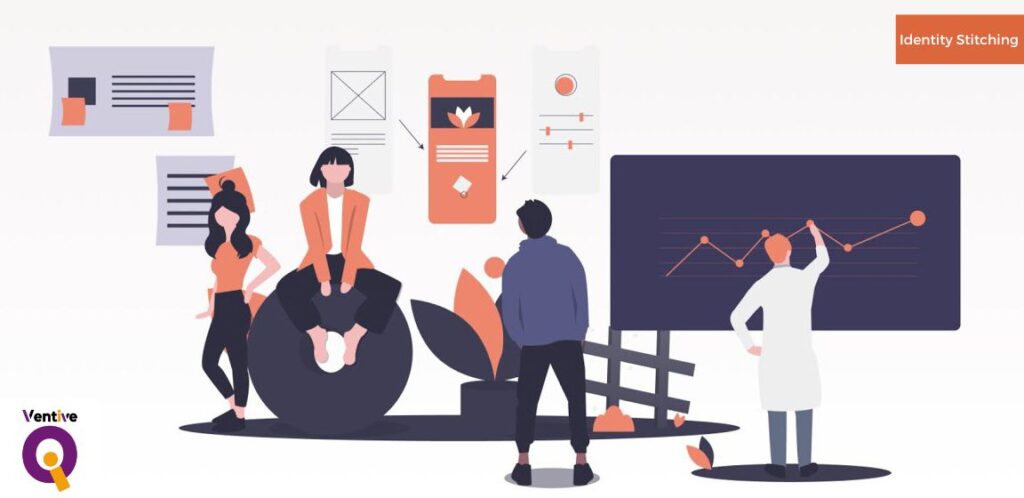In today’s digital age, customers interact with businesses via numerous channels and devices, leaving a trail of fragmented data behind. As a result, businesses often struggle to make a unified profile of their customers which can lead to missed opportunities and less compelling marketing tactics.
Identity stitching is a solution to this problem. It’s a process that entitles businesses to connect disparate data points and create a single, holistic view of the customer. By doing so, businesses can achieve a profound knowledge of their customers and provide more personalized experiences that drive customer loyalty.
Discover the power of an Identity Graph.

In this blog, we’ll dive into the world of identity stitching, exploring what it is, how it works, and why it matters for modern marketers.
What makes Identity Stitching important?
Making identity a priority should be a critical task for every marketer as it enables them to achieve audience relevance. With the increasing usage of multiple devices such as smartphones, laptops, tablets, smartwatches, and smart TVs, people engage in a lot of fragmented activity across various platforms. Moreover, since individuals are not always logged in to every device, it becomes challenging to identify their preferences across different platforms. The situation becomes even more complicated when we take into account shared devices.
Identity stitching matters because it enables businesses to create a complete view of their customers by merging fragmented data from various sources and touchpoints. Through this process, businesses can obtain valuable insights into their customers’ behavior, preferences, and requirements that they might not have access to otherwise.
With a complete view of their customers, businesses can enhance their marketing techniques, deliver more personalized experiences, and drive customer loyalty. For example, businesses can employ identity stitching to tailor their messaging and content to precise customers based on their interests, area, or past behavior. This can lead to higher engagement, increased sales, and sounder customer retention.
Moreover, identity stitching can help businesses stay compliant with data privacy laws by providing a transparent and secure way to gather, store, and use customer data. This is significant in today’s data-driven world, where customers are increasingly concerned about the use and protection of their personal information.
People-first identity
People-first identity in Identity Stitching refers to the practice of prioritizing the privacy and security of the customer’s personal information in the identity stitching process. This means collecting simply the essential data, being transparent about how the data is used, and protecting the data from unauthorized access and breaches.
People-first identity is significant because it helps build trust between the business and the customer. When customers know that their data is being handled with care and respect, they are more likely to share their information and engage with the business. Moreover, a people-first identity is essential in today’s world where data privacy regulations are becoming increasingly stringent, and customers are more conscious of their rights and how their data is being used.
Businesses that prioritize people-first identity can not only improve their customer relationships but also ensure compliance with data privacy regulations and protect their reputation in the market.
The Identity Ecosystem
The Identity Ecosystem refers to the network of systems, processes, and technologies that work together to collect, store, manage, and share customer data securely and efficiently. This ecosystem includes different elements such as customer relationship management (CRM) systems, data management platforms (DMPs), identity resolution technologies, and more.
The identity ecosystem is integral to the success of identity stitching as it allows businesses to connect disparate data points and form a single, comprehensive view of the customer. With a well-functioning identity ecosystem, businesses can collect and manage customer data from different sources, including first-party and third-party data and use it to drive their marketing techniques, improve customer experiences, and increase customer loyalty.
However, the identity ecosystem poses several challenges, particularly in terms of data privacy and security. As customer data is collected and shared across different systems and platforms, there is a risk of data violations and unauthorized access, which can lead to harm to their reputation and legal penalties. Thus, it is crucial to ensure that the identity ecosystem is designed and managed in a way that prioritizes people-first identity, transparency, and security.
What has identity ever done for marketers?
Identity has a considerable impact on various aspects of modern life, including business, government, and society.
Identity has revolutionized marketing by providing a more accurate understanding of consumers and their behaviors across numerous channels and devices. With the help of identity, marketers can personalize their messaging and experiences, target specific audiences more effectively, optimize advertising spend, and measure the result of their campaigns.
Identity likewise enables marketers to build stronger customer relationships and loyalty by delivering consistent and relevant experiences across all touchpoints. In general, identity has become a crucial element of modern marketing techniques and has remarkably improved the way marketers engage with their customers.
4 Benefits of Focusing on Identity
Identity provides a unified perspective of an individual across touchpoints, which offers advantages for both marketers and audiences.
1. Context-aware, respectful marketing
- By developing a comprehensive understanding of a person and acknowledging them as an individual rather than a mere segment or target group, contextually aware and respectful marketing can be achieved. This approach takes into account a person’s unique activities, needs, and preferences, rather than relying on assumptions.
2. Relevant, personalized experiences
- By implementing a comprehensive identity solution that addresses resolution, hygiene, stitching, and other factors, marketers and advertisers can bridge gaps in audience information and develop highly personalized experiences across multiple channels that take into account individual preferences and strengthen connections.
3. Accurate attribution, and intelligent decisions
- Consider all the signals a person generates throughout the day that can help identify them, including clicks on ads, email interactions using multiple email addresses, search queries, page views, and transactions. They lead busy lives!
- It can be challenging to keep track of all the signals that a member of your audience generates throughout the day, particularly across multiple devices and at a large scale. Identity solutions can help by mapping and attributing those identifiers, allowing you to not only recognize your audience but also analyze their journeys, assess channel effectiveness, and ultimately build more relevant and effective campaigns.
4. Control, compliance, and privacy
- Identity solutions provide a way to collate, update, enrich, and activate data (both personally identifiable information (PII) and non-PII) across platforms in a manner that is both consistent and compliant with evolving privacy regulations in the advertising industry.
Having a solution prepared in light of the decline of third-party cookies is crucial to maintaining compliance and retaining important connections with your audience, particularly with respect to privacy. It is always important to prioritize the fair, compliant, and ethical use of data, from both a legislative and consumer standpoint. Complete identity solutions are designed with these considerations in mind, to guarantee privacy by design in every circumstance.
Identify your identity needs
One way to approach managing and utilizing customer data effectively is to identify the specific identity needs of the business. This involves assessing the types of data that are required to achieve a comprehensive understanding of the customer & the systems and procedures needed to collect, store, and manage this data. By understanding their identity needs, businesses can leverage customer data to improve customer experiences, increase efficiency, and drive business growth.
Know more about the elements to consider while creating an identity graph.
Conclusion
Identity stitching is a valuable tool for businesses to gain insights into customer behavior and preferences, create personalized marketing messages, and improve overall customer experiences. It can also help businesses comply with data privacy regulations, build trust with customers, and protect sensitive information. Overall, identity stitching has a significant impact on modern business and society, and its advantages are numerous.



